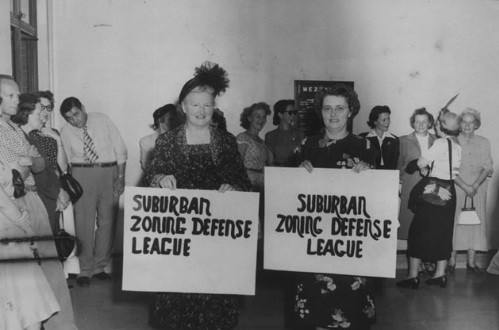Like other cities, Atlanta was transformed by transportation and housing policies in the mid-1900s that subsidized suburban growth for white homeowners, leaving the city core underfunded and crippling the ability of black families to build wealth.
“The effects have lasted for generations,” the report reads, describing what some have called the “$120 billion head start.” Those policies fueling residential segregation were inextricably tied to transportation in the region, said Alex Karner, a city planning professor with the Georgia Institute of Technology and co-author of the report.
As white families took advantage of racist housing policies and lending practices and headed to the suburbs, “the economic activity was still concentrated in the cities, so they needed some sort of link,” he said. Shortly after the U.S. Supreme Court ruled that segregated schools were illegal, “the freeway system comes online,” often running right through communities of color.
Enter MARTA. Though the metro area was largely segregated between suburbs and the central city, business elites still maintained an interest in making downtown economically vibrant and facilitating connections to the suburbs to manage traffic. Their interest in rail helped create MARTA, thanks to an act of the state legislature in 1965. Early on, the agency faced opposition from black voters, who rejected a proposed property tax in 1968 because they were “dissatisfied with a lack of input and the proposed design’s emphasis on suburb-to-downtown access,” the report explains.
In response, MARTA appointed a key critic to its board and reworked plans to include a major bus expansion and a rail line serving largely black neighborhoods as well as other changes. Black voters, in turn, helped pass the next funding referendum in 1971. But the measure failed in two of the four counties where MARTA was established. The two counties, notes the report, were rural and largely white. “Racial fears were certainly part of their opposition.”
Other scholars have chronicled “this racialized animosity toward transit” in Atlanta, including Jason Henderson, a geography professor at San Francisco State University. “Since it was established in the 1960s,” he wrote in a 2006 paper on the politics of automcobility in Atlanta, MARTA “was jokingly referred to as ‘Moving Africans Rapidly Through Atlanta.'” Indeed, he continued, “Every county in metropolitan Atlanta, with the exception of Fulton and DeKalb, had contentious local debates or referendums on either joining MARTA or establishing an independent, stand-alone transit system.”
Voters in suburban Gwinnett County rejected MARTA three separate times “under a cloud of racialized rhetoric,” he wrote. One suburban politician interviewed for his paper told Henderson that, the day a sign went up for a new park and ride lot in his district, ahead of the 1996 Olympics, “the county had to reroute overwhelmed phone lines in county offices due to radicalized, anti-transit anger.” The run-up to the Olympics, the report from the Partnership for Southern Equity notes, “was also when Atlanta began demolishing all of its public housing projects.”
What emerged was a sort of two-tiered system: highways for the largely white suburbs and a chronically underfunded public transit system for people of color and low-income people, many of whom had to get by without cars, said Karner.





